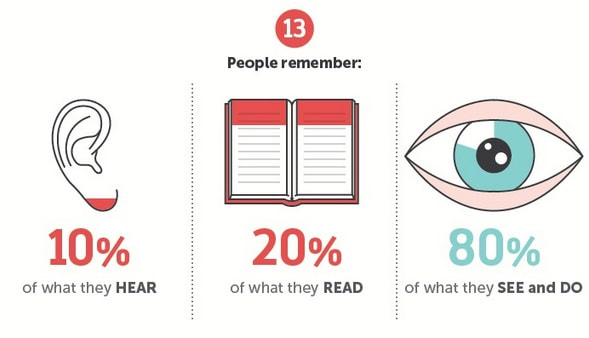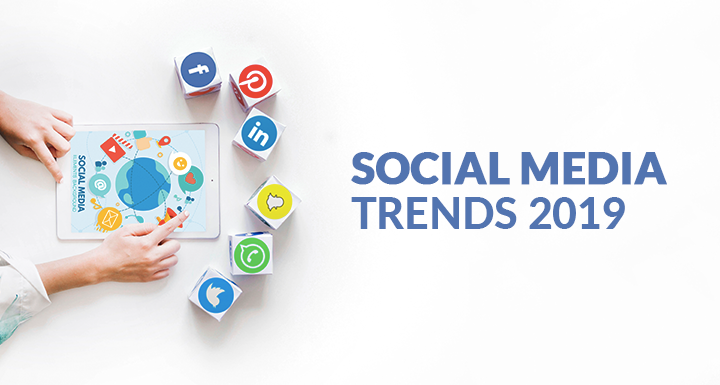|
As social media platforms have evolved into full-blown communication channels, more brands are relying on these platforms to reach their target audiences.
Consumer attention is scattered across various social platforms, not to mention apps and other online diversions. Brands that hope to capture consumers’ attention and dollars need to keep in touch with how their audiences utilise these platforms. The bottom line is that, as trends evolve on social media, so must the corresponding marketing. What is going to influence social media users? What does this mean for brand marketing? And what do we need to be aware of to stay current and relevant? Here are the top 10 social media trends to keep an eye on in the new year. 1. Rebuilding trust in social media platforms. Social media platforms continue to grow annually -- in fact, Facebook has more than 2 billion active users each month. However, the picture isn’t entirely rosy. Consumer confidence in social media is on shaky ground. Users are growing increasingly leery of the information they find on social media. And marketers may be contributing to the situation when they fail to properly label paid advertising posts or they bombard a platform with targeted ads that overwhelm users. All of this can leave users feeling distrustful of both the brand and the platform. Younger generations have little tolerance for marketing that comes off as disingenuous. Brands will need to look for ways to build consumer trust. That means focusing on ways to authentically connect with audiences, and ways to highlight their humanity. Brands need to connect with their audiences on a meaningful level. No one likes being constantly swamped with ads. Even worse is when you’re being marketed to and don’t even realise it. 2. Social media is about storytelling. Social media’s popularity is rooted in the fact that it allows us to share our life experiences with friends and families. We get to tell our stories through our posts, and we get to see a snapshot of everyone else’s lives through our news feeds. At first, that was through written posts and photos, but video content is increasingly popular. Social media is adapting, embracing new ways to allow people to tell their stories and share their narrative with the world. Instagram, Snapchat and Facebook are embracing this trend, and it’s changing the way we consume social media content. This opens the door for brands to share more human stories of their own, which will inspire audiences to try out their product. Storytelling feels real, immediate and personal, but it also demands a mix of more time-intensive video, images and graphics, and requires brands to be more creative and thoughtful in the intent. 3. Build a brand narrative.Along with honing their human stories, businesses are going to need to build a strategic narrative behind their brand. Narratives capture moments and experiences shared between a user and a product; they’re the conversations that are occurring, and they’re often about trying to create a broader, more positive change. These narratives can be distributed through social media and digital media, and they reflect what a brand’s community is saying about them. If a brand can build a larger story, it will have a better chance of success. Brand narratives need to be compelling and lead audiences to an action. Evaluate your brand story, and ensure it is inspiring and stands out against the messiness of other social media content. 4. Quality and creativity over quantity. Marketers often have a knee-jerk reaction to trends by flooding platforms with mediocre and uninspired content in hopes of riding the trend wave. Would-be customers react by tuning out and quickly dismissing sub-par messaging. The threshold for gaining customer attention and trust has grown exponentially. Marketers who hope to gain consumer consideration must be willing to go the extra mile in creating engaging content. The bottom line is, to have an impact, brands must be purposeful and creative. Less content, if it’s created thoughtfully and is well-positioned, will have greater impact than an abundance of content that is uninspired, heavy-handed or seen as shallow or dull. 5. Put a human face to your brand. Personal branding is a must on social media. Putting a real, human face to a brand is key in building trust and loyalty, especially for small, relatively unknown businesses. Personal branding gives a business a human element that will naturally connect customers and make the brand seem more relateable. Businesses that learn to foster their human element will have a real advantage over those who hide behind a logo. One popular trend in humanising a business is to promote the personal brand of the business owner or a high-level leader. This can be done through guest blogging, podcasts and webinars. Giving the public an up-close view of the company’s leader can strengthen its brand reputation. 6. Influencers continue to grow their communities. Influencer marketing continues to develop and grow on social media platforms. Influencers are social media figures who have gathered a defined community around themselves. Their large followings (which can range from the thousands to over a million viewers) give them influence over others. They can be incredibly effective as salespeople because we inherently trust the people we follow on social media. Much like personal branding, when done well influencer marketing gives a human voice to brands. Influencer marketing is less direct than traditional forms of advertising, but it can effectively create authentic ways of connecting with customers. 7. Selfie videos and branding. The selfie culture continues to flourish on social media, with the popularity of selfie photo evolving into the self-recorded video. These “selfie videos” are drawing high user interest on social media. Like the selfie photo, the selfie video allows users to capture a moment in time, but the video format allows users to communicate in a deeper and more personal way than a photo ever could. Selfie videos tend to be short and feel more immediate than a written post with a photo. Businesses need to take note: viewers spend hours watching friends’ videos on Snapchat, Instagram and Facebook. Brands would be wise to look for ways to incorporate first-person “selfie video” content as part of their marketing strategy. Traditional advertising can be off-putting to younger audiences, who are more cautious about their purchases and want a more authentic experience with their brands. The selfie video can help a brand seem more relateable and trustworthy. 8. Segment your social audiences. While brands talk about their customers and audiences, the reality is that most businesses will have multiple audiences. Segmentation is the process of organising your audience into manageable groups (or segments) so you can tailor your messaging and communications to the preferences of each group. Social media is most effective when you segment your audiences so you can be relevant to the right groups of people at the right time. Making assumptions about your audience and lumping them all together could limit your ability to reach more people. So the more you know about your audience and the various groups that make up your audience, the better you can adjust your messaging and narratives to fit each segment. 9. Hyper-targeted personalisation. Customers have come to expect brands to tailor special offers and discounts to their wants and needs. To keep up with expectations, businesses need to step up their game when it comes to targeted advertising. Nearly every social media platform offers some level of audience filtering when you opt to pay for advertising. These options range from simple geographic targeting to advanced filters that refine audiences into highly specific segments. In the coming year, brands will increasingly turn to hyper-targeted personalisation to reach their audiences. This is often achieved through re-targeting or re-marketing ads. Ever wonder why you’re seeing an ad on your social media site for something you were shopping for earlier? That’s hyper-targeted personalisation at work. Using “cookies” while you browse online, marketers collect data on users, such as online habits, the area they live in and any other pertinent information. But marketers will need to find a balance between being too pushy and being able to offer personalised advertising that will genuinely interest customers. 10. Know your platforms. Businesses should carefully consider which social media platforms to focus on, as each platform tends to be used by different groups. For example, over 80 percent of Pinterest users are female, and more than 50 percent of users are from the US. So, if a brand is targeting American women, posting on Pinterest could help isolate that group. Meanwhile, Snapchat users tend to be younger than those who use Facebook. And career-focused professionals spend more of their time on LinkedIn. Brands that use multiple platforms should use these distinguishing characteristics to decide where to post content and on which platforms to focus the majority of their marketing efforts.
0 Comments
A memorable brand can reinforce your difference from competitors and can help to encourage customer loyalty. But developing a lasting brand involves a lot more than simply redesigning your logo.
 What makes a memorable infographic? Her I explain the importance of creating a narrative and using a metaphor to present complex data in a clear and attractive way. Many infographics are so complicated that I’d rather read a chunk of well-written copy. But wasn’t the point of infographics to present us with easy-to-read, digestible chunks of information in an interesting and visually enticing format? Yes, information can be beautiful but it also needs to educate readers and remain in their minds long after they forget about the flashy design. However, done well, infographics are a great way of presenting data. But as everyone jumps on the infographics bandwagon, more and more seem to be focusing on creating complex artistry rather than making a comprehensible resource. Simplify your infographicsInfographics can be visually stunning but they must convey your message. They need to be educational as well as being aesthetically pleasing enough to share and link to. Here are some simple ways to create effective infographics. Create a narrative The best way to create a memorable infographic is by developing a narrative. Create a story within the design that is relevant to your niche and focus. Prioritise the data Creating a hierarchy of data will help your readers to visualise which data you deem most important. Bolder, larger fonts and graphics are a simple way of highlighting the key points you want to get across. Say it with metaphors Infographics are particularly useful when trying to convey an important message that is difficult to comprehend. One method for explaining the complex is to use metaphors. The element of surprise is always a good way to create memorable infographics. Execute the unexpected by looking for metaphors that people may not have associated with your niche before to help you stand out from the crowd. Illustrate the obvious However, some infographics take it too far when it comes to using metaphors. If something is easily explainable, illustrate the obvious instead of confusing the reader further. Don’t shy away from simply translating data into graphics that readers would naturally associate with key terms. If you're looking to create simple yet effective infographics, there are some fantastic infographic creator websites out there that are completely free to use at the basic level. |
AuthorLisa Hunter is an experienced Marketing, Events and Project Manager. She has over 10 years’ experience working in the IT and marketing industry, delivering strategic marketing support and managing creative projects for a wide-range of clients. In this blog she shares her knowledge and experiences…we hope you enjoy it. Archives
June 2019
Categories
All
|


 RSS Feed
RSS Feed